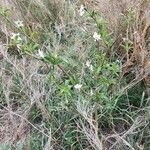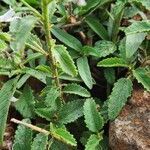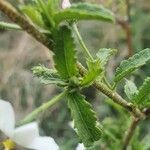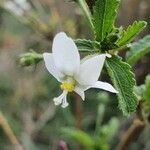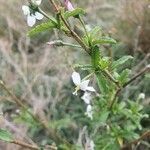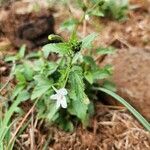An annual herb or shrub. It grows 70-300 cm tall. It can keep growing for a few years. The branches are straight. The stems are hairy. The leaf stalk is 5-20 mm long. The leaf blade is 20-45 mm long by 15-40 mm wide. The flowers are 1 cm across and white, pink or purple. They occur singly in the axils of leaves.
Leaf-lamina 1–5 × 0·5–2·5 cm., narrowly elliptic, oblong-elliptic to lanceolate-elliptic or suborbicular, stellate-hispid on both surfaces, apex rounded to acute, margin serrate, base obtuse to rounded; petiole 1–5 mm. long; stipules 3–5 mm. long, setaceous.
Flowers up to c. 1 cm. in diam. (small for the genus), white, pinkish or purplish, solitary, axillary, and forming racemes or panicles at the apices of the stems by reduction of the upper leaves; peduncle up to 2 cm. long, articulated near the middle.
Shrub, up to 2.5 m high. Indumentum of young stems stellate-setulose, hairs projecting up to 0.5 mm. Petals 5-8 mm long. Epicalyx 1-3 mm long. Staminal tube 2.0-2.5 mm long. Flowers white, pinkish or purplish.
Virgate shrub up to c. 2–5 m. tall; stems stellate-setulose, hairs somewhat projecting giving a slightly rough appearance.
Calyx up to 4·5 mm. long, setulose; lobes up to 4 × 2 mm., lanceolate, acute.
Staminal tube 2–2·5 mm. long; free parts of filaments up to 0·5 mm. long.
Petals 5–8 mm. long, obovate, pubescent outside, glabrous inside.
Capsule 7–8 × 8–12 mm., depressed-globose, minutely pubescent.
Epicalyx of 5–7 bracts; bracts 1·5–3 mm. long, filiform.
Style-branches 1–1·5 mm. long.
Seeds with white silky floss.
